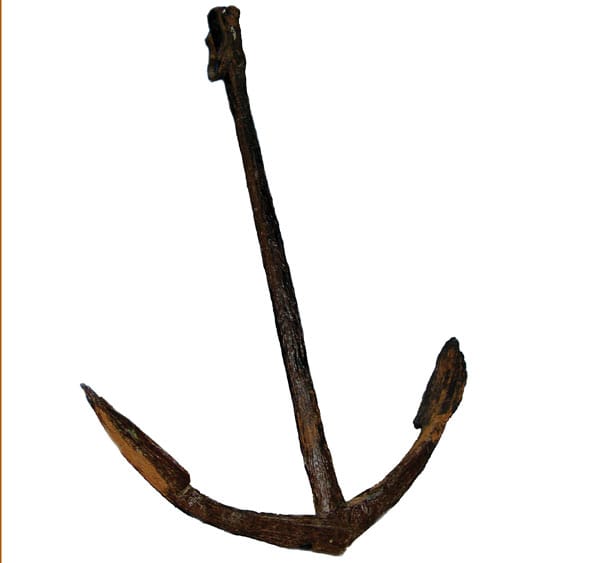After sailing the seven seas carrying lumber and gold diggers alike, the Marco Polo ended as she had begun-beached in Maritime sand.
"Yesterday a large ship built and owned by Mr. Smith at Courtenay Bay was launched from his building yard. On clearing the ways, her keel struck the sand and she fell over on her side. Several persons were severely injured by the chains, etc. which fetched way and run down to leeward on the deck."
Nobody reading that April 18, 1851, entry in the Saint John Weekly Chronicle describing the disastrous launching of James Smith's latest ship could have imagined the unlucky New Brunswick vessel would become the fastest ship in the world. Smith built the Marco Polo for the timber trade, with the configuration of a cargo ship above the waterline and the design of a much faster clipper ship below. As with today, time was money for 19th century merchants, and the faster a ship crossed the oceans, the faster profits from her cargo could be realized.

A three-masted, square-rigged, 184-foot-long three-decker of 1,625 tons, the Marco Polo failed to stop when she cleared her launchway, and ploughed into the mud on the opposite bank. It took two weeks of high tides and teams of oxen to refloat her-and the beaching created a permanent warp in the hull, making the bow and stern six inches lower than the centre of the hull. Some claim this was the reason for her great speed, while others speculate it was the arrangement and rake of her masts.
On her maiden voyage, under Captain William Thomas of Saint John, she carried timber to Liverpool, England, in 15 days, a journey that frequently took twice as long.
A year later, the Marco Polo was purchased by the Black Ball Line and refitted for the Australian trade route, carrying fortune-seekers to the newly discovered goldfields. Under her colourful skipper, Captain "Bully" Forbes, she beat the new steamer Australia by a week on her maiden Liverpool-to-Melbourne run, making the trip in 68 days with 930 passengers and 60 crewmen.
Life for passengers and crewmembers was harsh on Victorian sailing ships. Surviving journal entries tell of drunkenness, dogfights and death. Forbes was nicknamed Bully for good reason. On several occasions, he clamped both passengers and crew in irons for various infractions, and was not above threatening to throw them overboard, ladies included.
When Forbes got to Australia, concerned that some of his men might desert for the enticements of the goldfields, he had them temporarily jailed on trumped-up charges of insubordination. Forbes made it back to Liverpool in 74 days, a remarkable five months and 21 days after he left, a new record and the first global circumnavigation of less than six months.
The vessel and her captain were the talk of the shipping world. Between the ship's fore and main masts, a long ribbon of canvas now proclaimed her "The Fastest Ship in the World." The Marco Polo's success resulted in increased demand for ships made in New Brunswick, and soon shipyards across the province were working at capacity. In 1854 alone, 40 ships were launched from the province, and Saint John became the third largest shipbuilding centre in the world.
In 1857, 20-year-old Samuel Napier of Bathurst sailed as a crewman on the Marco Polo to Australia, where his brother Charles was prospecting for gold. He jumped ship, joined Charles on a small claim in Victoria and began digging. On August 14, having dug down 13 feet, Sam's pick struck what he thought was a rock. The "rock" turned out to be a gold nugget weighing more than 119 pounds, the largest ever discovered at the time.
Fearing for their safety, the Napier boys shipped the nugget to England in secrecy, where they sold it to the Bank of England for $60,000-about $1.5 million in today's money. The Napiers became the toast of London society and even had an audience with Queen Victoria. With their new-found fortunes, Charles returned to Australia, while Sam went home to Bathurst, where he built a fine house in the centre of town-though he later died in poverty in a remote cabin in Quebec.
Meanwhile, the Marco Polo continued her fast voyages to Australia, and beat the steamer Great Britain by eight days in 1867. A year later, as iron steamships began to replace wooden sailing ships, she was sold and used to haul coal, timber and guano. Water-soaked and strained, her hull was held together by chains while pumps worked continuously to keep the sea out.
In 1883, the Marco Polo sailed from Montmorency, Que, with a cargo of pine lumber for Europe. She was caught in a gale in the Gulf of St. Lawrence, began leaking badly-and the pumps were unable to keep up. Shortly after noon on July 25, the residents of Cavendish, PEI, were astonished to see the Marco Polo, all sails set, heading for the beach. After sailing the seven seas for 32 years, she grounded about 300 yards offshore, and her 20-man crew were brought ashore by locals.
A month later, while a salvage company hired to strip the ship was working on board another storm struck, leaving workmen stranded on the vessel. Several attempts to rescue them met in failure, until Captain Macleod of French River braved the tempest and saved all but one. During another storm a week later, the Marco Polo broke up and disappeared beneath the waves. Many items were salvaged from the wreck and later sold at an auction before this last storm carried her to a watery grave.
In 1962, divers found the wreck of the vessel in approximately 12 yards of water. Several objects were recovered, including two huge anchors and sections of hull with original oakum still wedged securely between the planks.
Today, many older homes in Cavendish boast of a "souvenir"-some legitimate, some alleged-from the Marco Polo. It's been said that if all the artifacts claimed to have come from the vessel were assembled, it would make two of the original. Fortunately the ship's figurehead, a carved reclining figure of Marco Polo, is preserved in the New Brunswick Museum at Saint John.
Inspiring a young author
The Marco Polo grounded just off the front doorstep of an eight-year-old Cavendish girl, having a profound influence on the child's life. In 1890, when the lass was 15, one of her teachers encouraged her and her fellow pupils to enter an essay competition sponsored by the Montreal Witness newspaper; her essay was "The Wreck of the Marco Polo." The following year her article was published in the Witness and reprinted in the Charlottetown Daily Patriot.
The story of the Marco Polo was the girl's second piece in print; she had already had a poem called "The Legend of Cape Leforce" published in the Patriot a few months earlier. The budding young writer's name was Lucy Maud Montgomery, who went on to become the world-famous author of the Anne of Green Gables books.
